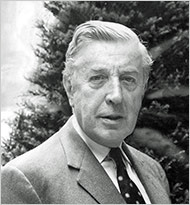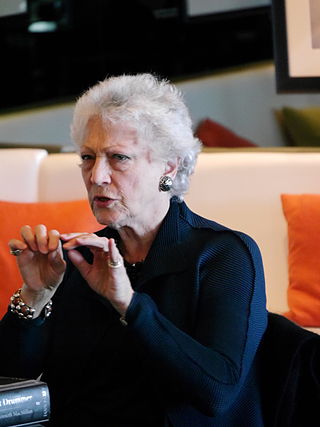Related Research Articles

Dame Ninette de Valois was an Irish-born British dancer, teacher, choreographer, and director of classical ballet. Most notably, she danced professionally with Serge Diaghilev's Ballets Russes, later establishing the Royal Ballet, one of the foremost ballet companies of the 20th century and one of the leading ballet companies in the world. She also established the Royal Ballet School and the touring company which became the Birmingham Royal Ballet. She is widely regarded as one of the most influential figures in the history of ballet and as the "godmother" of English and Irish ballet.

Sir Robert Murray Helpmann CBE was an Australian ballet dancer, actor, director, and choreographer. After early work in Australia he moved to Britain in 1932, where he joined the Vic-Wells Ballet under its creator, Ninette de Valois. He became one of the company's leading men, partnering Alicia Markova and later Margot Fonteyn. When Frederick Ashton, the company's chief choreographer, was called up for military service in the Second World War Helpmann took over from him while continuing as a principal dancer.

Sir Frederick William Mallandaine Ashton was a British ballet dancer and choreographer. He also worked as a director and choreographer in opera, film and revue.

The Royal Ballet is a British internationally renowned classical ballet company, based at the Royal Opera House in Covent Garden, London, England. The largest of the five major ballet companies in Great Britain, the Royal Ballet was founded in 1931 by Dame Ninette de Valois. It became the resident ballet company of the Royal Opera House in 1946, and has purpose-built facilities within these premises. It was granted a royal charter in 1956, becoming recognised as Britain's flagship ballet company.

The Royal Ballet School is a British school of classical ballet training founded in 1926 by the Anglo-Irish ballerina and choreographer Ninette de Valois. The school's aim is to train and educate outstanding classical ballet dancers, especially for the Royal Ballet and the Birmingham Royal Ballet.

Dame Monica Mason is a former ballet dancer, teacher, and artistic director of The Royal Ballet. In more than fifty years with the company, she established a reputation as a versatile performer, a skilled rehearsal director, and a capable administrator.

Sir Kenneth MacMillan was a British ballet dancer and choreographer who was artistic director of the Royal Ballet in London between 1970 and 1977, and its principal choreographer from 1977 until his death. Earlier he had served as director of ballet for the Deutsche Oper in Berlin. He was also associate director of the American Ballet Theatre from 1984 to 1989, and artistic associate of the Houston Ballet from 1989 to 1992.
Arnold Lionel David Haskell was a British dance critic who founded the Camargo Society in 1930. With Ninette de Valois, he was influential in the development of the Royal Ballet School, later becoming the school's headmaster.
Sir Peter Wright CBE is a British ballet teacher, choreographer, director and former professional dancer. He worked as a choreographer and as the artistic director of Birmingham Royal Ballet, a classical ballet company based in Birmingham, England. On retiring from the company in 1995, he was bestowed the honorary title of Director Laureate of the company.

Dame Beryl Elizabeth Grey was an English ballet dancer.
Leslie George Edwards was a British ballet dancer and ballet master. He was one of the final links with Ninette de Valois's original pre-war Vic-Wells Ballet. Apart from two years of military service during the Second World War, his entire 60-year career was effectively spent with what became the Royal Ballet organisation, until his final retirement from the stage in 1993.
British ballet is most recognised for two leading methods, those of the Royal Ballet School and the Royal Academy of Dance. The identifying characteristic of British ballet is the focus on clean, precise technique and purity of line that is free of exaggeration and mannerisms. The training of dancers in Britain is noted for its slow progression, with a great deal of attention paid to basic technique. British ballet methods operate on the principle that establishing correct technique and strength slowly makes it much easier for the student to adapt to more difficult vocabulary and techniques later on.
Les Patineurs is a ballet choreographed by Frederick Ashton to music composed by Giacomo Meyerbeer and arranged by Constant Lambert. With scenery and costumes designed by William Chappell, it was first presented by the Vic-Wells Ballet at the Sadler's Wells Theatre, London, on 16 February 1937. It has been called "a paradigm of an Ashton ballet, perfectly crafted with a complex structure beneath the effervescent surface."
June Brae was a British ballet dancer, who created leading roles for Frederick Ashton, Ninette de Valois and other choreographers.
Henry Danton was a British dancer, teacher, and stager of classical ballet.
Harold Turner was an English ballet dancer, teacher, and ballet master. Widely recognized as "modern British ballet's first male virtuoso," he had an illustrious career as a principal dancer, after which he continued to perform in character roles. He is acknowledged as a key figure in British dance history.
The Camargo Society was a London society which created and produced ballet between 1930 and 1933, giving opportunity to British musicians, choreographers, designers and dancers. Its influence was disproportionate to its short life. Dame Ninette de Valois, founder of The Royal Ballet, saw it as "having done much for the cause of English ballet", and Encyclopædia Britannica Online credits it with "keeping ballet alive in England during the early 1930s". The society was named after the eighteenth-century French dancer Marie Anne de Cupis de Camargo.
Desmond Doyle was a South African ballet dancer who performed in England in the 1950s and 1960s before becoming ballet master of The Royal Ballet.
Gordon Hamilton was an Australian ballet dancer.
The Prospect Before Us is a one act comic ballet in seven scenes, choreographed for the Vic-Wells Ballet by Ninette de Valois to music by William Boyce arranged by Constant Lambert.
References
- 1 2 Jann Parry (7 October 2010). Different Drummer: The Life of Kenneth MacMillan. Faber & Faber. p. 64. ISBN 978-0-571-27451-2 . Retrieved 14 June 2015.